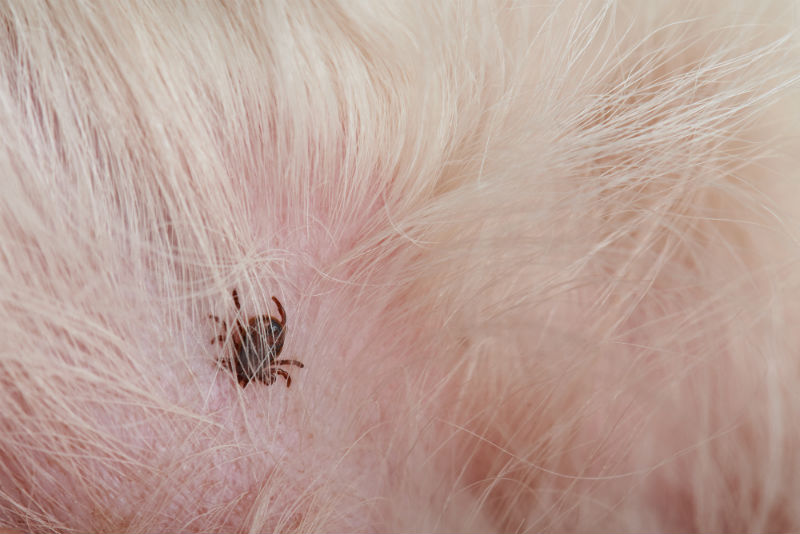Ticks are an external parasite that is growing in population here in Nova Scotia. They are eight-legged and seeking a blood meal from their hosts and have gained a reputation for being a shudder-inducing critter to stumble across. Due to their direct interaction with their host’s blood, disease transmission is common when they can stay attached to their host for several hours. Ticks embed their heads under the skin and can attach for days at a time. Due to their direct contact with the bloodstream, they are easily able to transmit diseases into the body of their host.
Lyme – Lyme disease is an infection of the tissues that can lead to lameness and can vary widely in severity. It occurs in both dogs and humans and can lead to kidney failure and even death. With dogs, symptoms can be difficult to detect and may not appear until several months following infection, and some animals are also asymptomatic. The “bulls-eye” mark on the skin only occurs in human cases – dogs do not have this indicator.
There is a blood test for dogs, but we need to wait six weeks after a tick bite or suspected infection for accurate results. Because the symptoms can mimic other conditions and have a tendency to come and go, it can be tricky to diagnose. It is transmitted by the black-legged deer tick in our area.
Symptoms
- Spontaneous and shifting leg lameness that lasts 3-4 days
- Loss of appetite/depression
- Reluctance to move
- Fatigue
Anaplasmosis – There are two forms of anaplasmosis: Anaplasma phagocytophilium and anaplasma platys. Anaplasma phagocytophilum is an infection of the white blood cells that is transmitted by the same ticks that carry Lyme disease—the black-legged deer tick and the western black-legged tick. Because of this, the risk of co-infection with Lyme disease and anaplasmosis is common. This infection can infect people as well as pets. Anaplasma platys is an infection of the blood platelets that can lead to bleeding disorders and is transmitted by the brown dog tick. Both of these diseases can be difficult to detect due to their vague symptoms.
Symptoms of Anaplasma phagocytophilum
- Lethargy
- Loss of appetite
- Lameness/reluctance to move
- Neck pain or neurologic signs in some cases
Symptoms of Anaplasma platys
- Bruising on the gums and belly
- Spontaneous nosebleeds
Babesia – Also known as babesiosis, it is a disease that affects the red blood cells. When the pet’s immune system tries to eliminate the infected blood cells, anemia, pallor and general weakness may occur. This disease can also affect people and is found in Canada and the US. It is transmitted by the brown dog tick. However, it can also be transmitted from an infected dog to another if an infected dog bites the other while fighting or playing.
Symptoms
- Lack of activity/lethargy
- Generalized weakness
- Vomiting
- Loss of appetite
- Weight loss
Ehrlichia – Sometimes going by the name ehrlichiosis, this is a type of rickettsial infection. It is a bacterial disease that comes in multiple forms depending on the type of tick and region it is obtained. Ehrlichia Canis is spread via the brown dog tick, and Ehrlichia Lewinii is spread via the Lone Star Tick and is the two that are the primary concern for dogs. Despite this, these bacteria can infect other animals as well including humans.
The symptoms of Ehrlichia may not be apparent. If left untreated, these diseases could progress to a chronic infection, which can last for days up to years without showing any symptoms.
Ehrlichia Canis is an infection of white blood cells that can eventually affect bone marrow function, including the production of blood cells.
Symptoms
- Depression and lack of energy
- Loss of appetite
- Runny eyes and nose/discharge
- Spontaneous nosebleeds
- Bruising on gums and belly
- Lameness/joint pain
Ehrlichia ewingii is an infection of the blood cells that can lead to joint pain and lameness.
Symptoms
- Loss of appetite
- Lethargy
- Spontaneous and shifting leg lameness, reluctance to move
There are three stages of Ehrlichia: acute stage, subclinical stage and chronic stage. The acute phase is where symptoms occur around 1-3 weeks after the bite from an infected tick and involve symptoms such as enlarged lymph nodes, lethargy, difficulty breathing, and limb edema (swelling). The subclinical stage is where the bacteria is still present without clinical symptoms, which can last months or even years. The chronic phase is where the long-term effects of the infection take a drastic toll on the body. Symptoms include abnormal bleeding, severe weight loss, trouble breathing due to inflammation of the lungs, head tilt, paralysis, kidney failure, and more.
Diagnosis
Testing for Ehrlichia includes CBC (complete blood count), urinalysis, and often more specific tests that help isolate the bacteria type. With this disease, a condition called thrombocytopenia can occur, which is a decreased number of platelets in the body, as well as a decrease in neutrophils (a type of white blood cell). Anemia and an increased number of lymphocytes (a type of white blood cell usually seen in advanced infections) are common too. Proteins present in the urine can indicate an inflammation of the kidneys. Other indications are hemorrhages within the retina of the eye, inflammation of the lungs, an enlarged spleen, and inflammation of the brain or spinal cord.
With treatment, the primary objective is to stabilize the patient and manage complications such as the bleeding related to the disease. Antibiotics are the leading choice of treatment along with anti-inflammatory medications for reducing swelling and inflammation. Fluid therapy may be warranted to maintain the pet’s hydration level and support the cardiovascular system, and, if the anemia is severe, a blood transfusion may be required. Treatment is determined based on the stage of illness your pet is experiencing. Prognosis is best when treatment is begun early. The best preventative is to use tick preventative products and to check your pet’s skin and fur regularly for the presence of any ticks.
Living and Management
Most pets recover well once treated, especially if it’s done early. Some dogs recover clinically, which means they do not show symptoms, but the infection is not entirely gone, remaining in the body and sometimes returning down the road. To determine your dog’s progress, repeat blood tests will be done during follow-up examinations and medications may be changed depending on your pet’s progress.
Written by Tracey Westhaver




